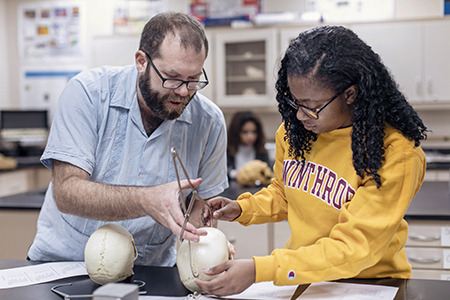 ROCK HILL, SOUTH CAROLINA—Winthrop University’s Brent Woodfill is in a race against time – a race to save and preserve a collection of historic
Maya artifacts dating more than 1,200 years old before urban sprawl covers the ruins.
ROCK HILL, SOUTH CAROLINA—Winthrop University’s Brent Woodfill is in a race against time – a race to save and preserve a collection of historic
Maya artifacts dating more than 1,200 years old before urban sprawl covers the ruins.
The National Science Foundation (NSF) awarded Woodfill, an assistant professor of anthropology, a $12,152 grant to salvage, map and excavate the remaining artifacts in the city of Coban, Alta Verapaz, Guatemala. The artifacts, which he said are “likely the largest figurine workshop yet encountered in the Maya world,” will then be examined by specialists from The Smithsonian Institution for further analysis and sourcing.
Woodfill will present some of his research April 10-14 at the Society for American Archaeology Annual Meeting in Albuquerque, New Mexico. This summer, he’ll return to the site with his team of American students and professionals and Guatemalan students.
Woodfill has spent years working on dig sites at the southern edge of the Maya lowlands. An acquaintance who also happens to be the regional inspector of monuments for Verapaz called Woodfill last year and told him there was something he needed to see.
That something? “An amazing find,” Woodfill said: a giant figurine workshop from the end of the Late Classic period in Maya history (approximately A.D. 750-950). The collection includes hundreds of beautiful molds and figurines featuring an elaborate Maya style, which the Maya people are believed to have traded throughout the northern highlands and lowlands.
“It looks like it was all just a single, relatively short occupation,” Woodfill explained, “but since a lot of the ceramics are actually a bit later, it looks like the people from this town really reached their peak of influence and power after a lot of the lowland cities started to collapse, which is something we've long suspected about the area but never been able to prove.”
The site, “El Aragón,” isn’t in the best condition, with newly minted and level housed lots, roads cut through and some leveled hills. Due to urban sprawl, political strife and a lack of monumental architecture, little work has been done in the region. In fact, the last archaeological investigation of the region was in 1952.
While Woodfill and other experts consider the site a rare opportunity, the window for the project is quickly closing. The city of Coban continues to push out into the countryside, and families have already purchased lots in the part of the site in which he’s worked. He just released his new book, "War in the Land of True Peace: The Fight for Maya Sacred Places," from the University of Oklahoma Press.
He’s talked about the project in his forensic anthropology and intro to archaeology classes, and hopes to return to Guatemala soon, ideally with students in tow.
Woodfill fell in love with archaeology at a young age and discovered the Maya during a Study Abroad course through the Yucatan Peninsula. He also spent time working in caves and sites in Belize. Since 2009, he’s worked at the site of Salinas de los Nueve Cerros, the Maya lowlands, receiving invitations from leaders there to conduct research. He and his team have also been able to repair local infrastructure, provide access to clean water, and found a development project to train and create staff for better ties with national and international development agencies.
Woodfill holds two bachelor’s degrees in English and anthropology from Macalester College; and a master’s and Ph.D. in anthropology from Vanderbilt University.
For more information, contact Nicole Chisari, communications coordinator, at 803/323-2236 or chisarin@winthrop.edu.